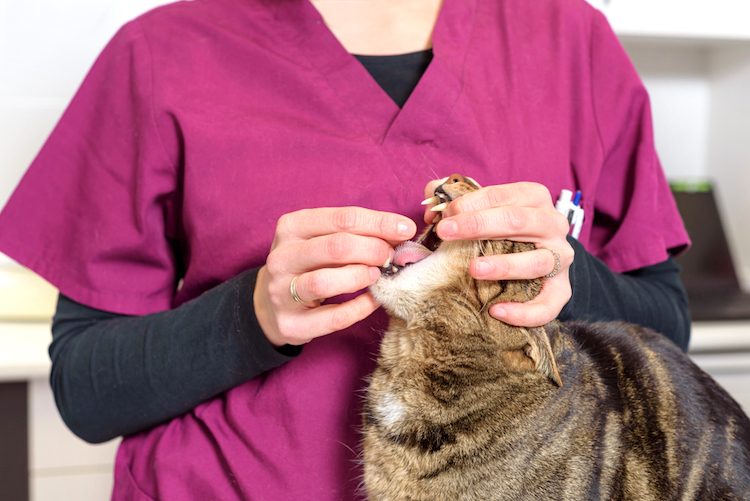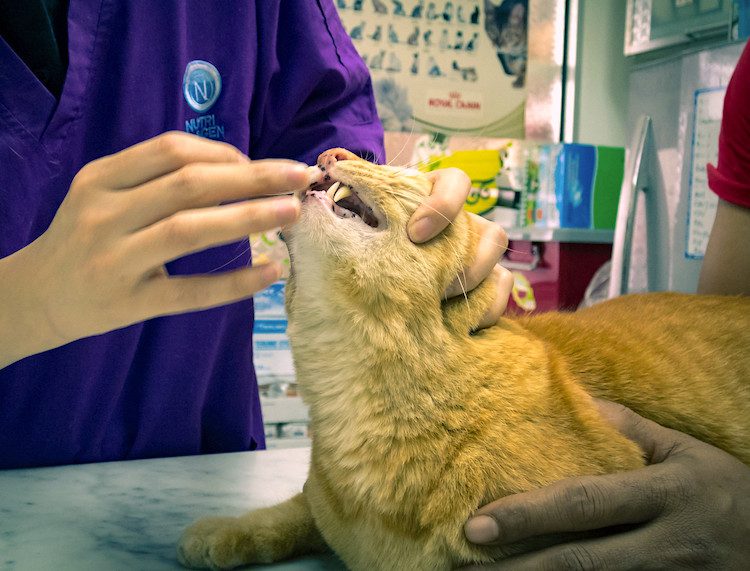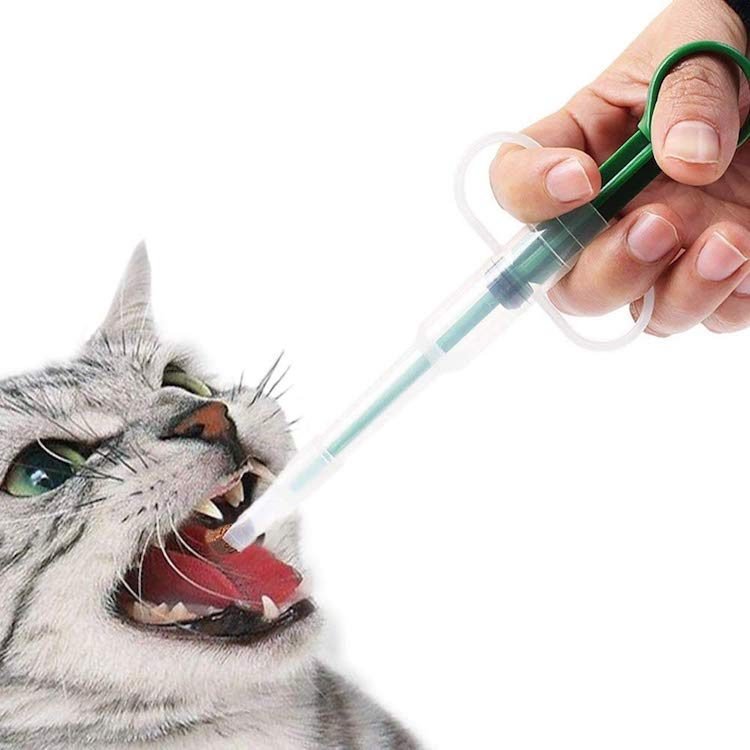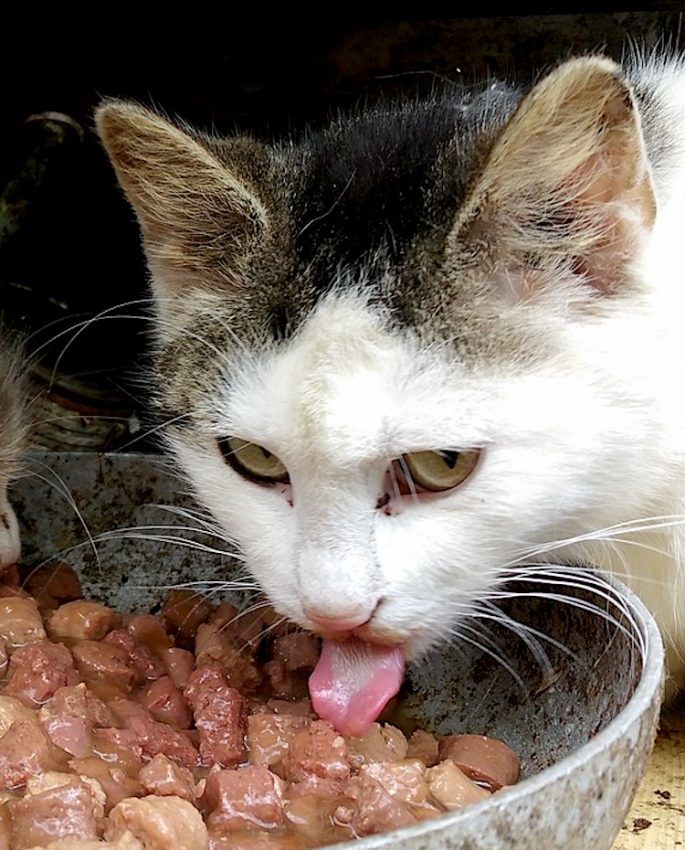
As a veterinarian, I’ve been tasked with medicating thousands of cats over the years. And whether I’m trying to show people how to give medicine to a cat or medicating my own beloved felines, it’s a challenge!
Many fabulous cats have shared my household over the past 40 years. I lost count at 50 (not all at the same time).
Quite a few of these cats lived in my home or shared a big feline life in my big barn of a veterinary hospital because their families had given up on them.
And why did these people give up on them?
Because often they didn’t understand exactly how to give medicine to a difficult cat — or they simply didn’t want to bother with it.
I am here to tell you this is a serious topic indeed, and one that’s close to my own heart. Many cats are euthanized because people can’t give their cat a pill. That’s not good.
The Veterinarian’s Job
- Honestly discuss with you how much you know about how to give medicine to a cat.
- Ask how much experience you’ve had medicating this particular cat.
- Go over all the formulations available for the specific medication, such as pill, liquid and transdermal.
- If the cat needs polypharmacy (many medications for a complicated illness or multiple illnesses), talk honestly with you about which medications are the most important or consider having several meds compounded together when possible.
- Have a veterinary technician spend time with you to show exactly how to administer the medication to your cat.
It’s easy for vets to send home a week’s worth of pills and not talk to the client about it. In many cases, these cats will not get their full dose of medication.
So, What’s the Trick for How to Pill a Difficult Cat?
It’s time for a hard truth …
There is no “one technique” that’s the best way to get a cat to take a pill or that enables all people to give pills to all cats.
Below, we’ll discuss a few different methods, starting with willing cats (easy enough) and then working our way to the unwilling cats (impossible to pill).
First, let’s run down a few important facts:
- Fact: Some cats can’t be pilled.
- Fact: Some people are physically or emotionally unable to pill a cat.
- Fact: It’s important to establish the medication routine early so the cat will be able to get the meds they need in some form or other.
- Fact: The human–animal bond is very important, and giving medication shouldn’t jeopardize that.
- Fact: It’s up to you and the vet to work this out.

Why Don’t Cats Like to Take Medicine?
The process of giving a cat a pill can be difficult. For some pet parents and their feline friend, the experience can be stressful- but why? Well, some say it could be that cats are picky and making them do something they don’t want to do is hard.
However, there can be many reasons why it’s difficult to give a cat medicine. Learning how to pill a difficult cat or give cats oral medicine in general can be beneficial to make the process go smoother, but it can still prove difficult. That’s why it’s so important to have open communication with your vet to ensure they are aware of the struggles and are told when giving cats medicine is not working out.
How to Give Medicine to a Cat (When the Cat Is Willing)
Some cats are easy to pill.
I can often find this out in the office exam when I administer the first pill. Although it may not be as easy the pet parent back at home, I can usually tell if this is going to be a positive and successful pilling situation or a disaster.
Some online instructions for how to give a cat a pill and how to hold a cat show a right-handed person (which most of us are) restraining the cat in their right arm while giving the pill with their left hand. That doesn’t work for me, a right-handed person.
After pilling thousands of cats, I’ve found that what works best for me is to cuddle the cat in the crook of my left arm and deliver the pill with my right hand into the cat’s mouth.
Was YOUR Pet Food Recalled?
Check Now: Blue Buffalo • Science Diet • Purina • Wellness • 4health • Canine Carry Outs • Friskies • Taste of the Wild • See 200+ more brands…

Instructions for Giving a Cat a Pill
Always follow your own vet’s instructions, but here’s a summary of the step-by-step instructions provided by Washington State University College of Veterinary Medicine:
- Cup the palm of your non-dominant hand around the top of the cat’s head.
- Tilt the head back — the cat’s lower jaw will usually open when you do this. If not, you’ll have to pry the lower jaw open.
- While holding the pill between the thumb and index finger of your dominant hand, place your middle finger of that hand into the cat’s mouth, over the small incisor teeth — NOT over the sharp fangs (canines). Warning: The cat might bite. Work quickly.
- Drop the pill back as far as you can over the cat’s tongue.
- Close the mouth quickly. Stroke the cat’s neck to encourage swallowing, or blow on the cat’s nose.
As Washington U. states: “Use caution when giving a cat oral medication to avoid a bite. A cat’s mouth contains many bacteria, and cat bites are often deep punctures.”
If the cat bites you, go see your doctor right away, even if you don’t think it’s that big a deal. Why? Because there’s a very real risk of infection. For more on this, see my article “Did a Cat Bite You? It’s a Bigger Deal Than You Think.”
Additional Tips and Reminders for Giving a Cat a Pill
- Never approach the cat straight ahead. Cats don’t like to be approached this way. Instead of going face forward, envelope the cat in your arms or approach from behind.
- Develop a technique that lessens the stress. Figure out what suits you and your cat, and make sure this pilling exercise gets done quickly. “If at first you don’t succeed, try, try again” does not work with kitties. Your cat’s vision of that old adage is “If at first you don’t succeed, go blank yourself and I am under the bed.”
- Attempt a routine where the cat gets the medication and then food, treat, etc. I will admit this works better with dogs, but some cats are willing to get a pill and then get their meal.

How to Give Medicine to a Difficult Cat
If you want to know how to give cats medicine, then it’s important to know that some cats make it extremely difficult. Some are unwilling to take a pill or capsule. This makes it truly impossible. With these cats, it’s just not going to happen, so you’ll need to find an alternative.
Pill Guns
I don’t know. Maybe these work? For some people?
A pill gun, or “pet pillar,” is a short plastic implement where you place the pill and send this little plastic tube down into the cat’s mouth and push, and the pill is supposed to go down the throat.
“This way, your hands stay clear of teeth and you have a better chance of getting the pill in the sweet spot where swallowing is easier than spitting it out,” says Dr. Tony Johnson, DVM, DACVECC.
As you can imagine, however, it often does not go down well (pardon the pun) when the cat sees a white implement coming at them face forward, so I’m pretty skeptical of pill guns for cats.
Liquid Medication
Many people prefer to give liquid medication to their cat, and this is possible with many medications.
So, how to give a difficult cat liquid medicine? You do this in much the same way as with a pill: You try to open the cat’s mouth and give the dropperful of medication directly to the cat.
Watch out. The folks at Washington U. warn that “liquids are more likely to accidentally enter the windpipe compared to pills or capsules. To avoid the cat inhaling liquid into the windpipe, DO NOT tilt the cat’s head backward.”
Can You Put Liquid Medicine in Cat Food?
The most common question I’m asked when I prescribe a liquid is “Can I mix it with her food?”
Well, probably not. Here’s why:
- Medication, even kitty-flavored, doesn’t taste great. If you mix the liquid medication with cat food and they don’t eat the food, they don’t get the medication! Seems like a Well, duh! moment to me, but many folks just keep putting the meds in the food and don’t understand. Even if the cat eats some of the food, they are not getting their proper dose.
- Food aversion. Many cats who need medications are not feeling well. Anything that makes them avoid their food is not good. Mixing meds into the food can create food aversion. Even if you stop putting the medicine in the bowl, the cat might avoid the dish for several days.

Compounding Pharmacies: An Alternative for Impossible-to-Pill Cats
There is a now a niche industry that caters to pets, particularly finicky cats.
These specialized pharmacies compound almost any medication into a form prescribed by you and your veterinarian.
Pros of Compounded Flavored Formulas
- Pills and liquids can be made into flavored medications of your kitty’s choice. Tuna, salmon, chicken, you name it. The list of flavors is extensive.
- Transdermal gels are also an option. These are most popular when having to give medications for a long time, such as the case with hyperthyroid cats. A small amount of gel can be placed on the inner ear, for example, and absorbed through the skin.
- Multiple medications (polypharmacy) can be formulated together — so instead of giving 3 medications, you can give 1. This might be advantageous in the case of a cat with renal failure, heart disease and/or hyperthyroidism.
Cons of Compounded Flavored Formulas
Expense
It costs more to have a medication compounded.
Some medications we might be giving to cats on a long-term basis might be very inexpensive in basic pill form but can triple in price if you have them compounded.
Short Shelf Life
Whenever you compound a drug, it is usually good for only 30–45 days. This means you must be vigilant about calling ahead and keeping up when your cat needs refills.
Convenience
Working with a compounding pharmacy can be positive or negative. You can usually get your cat’s meds shipped to your door, but this means thinking ahead and calling in refills before you run out.
Some vets might stock the most commonly used feline drugs in a compounded form, but you need to work this out with your vet before you run out.
Quality
As in any industry where a buck is to be made, there are some bad actors. Compounding veterinary drugs requires an ethical and highly trained pharmacist who knows how to obtain the best medication and then place it in a suspension or flavored pill or gel that is stable.
Your vet should choose the pharmacy, and you should stick with that recommendation.
Bioavailability
In the form dispensed, is your cat getting the proper dose and is all the medication being absorbed properly in their body?
- Liquid suspensions must be continually shaken and kept in a uniform suspension.
- Transdermal gels may not be as effective as giving an oral dose of medication.
- Directions (such as refrigerate, keep in a dark place, etc.) must be carefully adhered to.

A Possible Problem With Dry-Pilling a Cat: Esophageal Strictures
Pills can easily get stuck in a cat’s esophagus and cause major problems.
The esophagus is the tube that leaves the mouth and brings food and medications into the stomach. Cats are at strong risk for having pills get lodged in the esophagus and not move.
When a pill gets stuck in the cat’s esophagus, it begins to cause irritation. That irritation can go on to create a kind of scarring (called a stricture) that narrows the esophagus and can lead to the cat’s inability to have food pass through the esophagus into the stomach.
Some medications, such as doxycycline, an important and frequently prescribed feline medication, are particularly toxic to the esophagus. Most vets dispense a drug like doxycycline only in a liquid form.
Recent studies about feline esophageal strictures have recommended that pet parents give about 5 ml (1 teaspoon) of water to a cat after giving a pill. Yikes! You thought the pilling was bad enough? Now force a syringe full of water down your cat’s mouth? Good luck with that.
Here’s an instructive video from Concierge Mobile Animal Hospital on how to give a cat liquid medicine as well as a pill:
Final Thoughts on How to Give Medicine to a Cat
I’ve been at this a long time. One of the worst things for a feline veterinarian is working up a fabulous kitty and figuring out what is wrong and prescribing medication — and then finding out the loving pet parent can’t give it.
And they don’t tell me.
So, please: Talk to your vet. Get more instructions if you can’t give the medication prescribed. Look for alternatives.
If you can’t talk to your vet honestly, find another one. We are out there.
References
- “Giving Oral Medications to Your Cat.” Washington State University College of Veterinary Medicine.
- “Medicating Your Cat.” Ryan Veterinary Hospital at the University of Pennsylvania School of Veterinary Medicine.
- Sumner, Catherine, DVM, DACVECC. “Drug Interactions.” The MSPCA-Angell.
- Freeman, Lisa M., DVM, PhD, DACVN. “Pill-Popping Pets: Are the Foods You Use to Give Pills Safe?” Cummings Veterinary Medical Center at Tufts University. Sept. 4, 2018.
- Johnson, Tony, DVM, DACVECC. “Pilling Dogs and Cats.” Veterinary Partner. Sept. 17, 2014.
- Boothe, Dawn Merton, DVM, PhD, DACVIM, DACVCP. “Transdermal Gel Delivery in Cats: Fuss or Must? (Proceedings).” dvm360. May 1, 2011.
- Becker, Marty, DVM. “Something You May Not Know About Pilling Cats.” Dr. Marty Becker Blog. Sept. 17, 2014.
- German, Alex, BVSc, PhD, DipECVIM-CA, MRCVS.
This pet health content was written by a veterinarian, Dr. Debora Lichtenberg, VMD. It was last reviewed July 30, 2019 and updated April 19, 2024.
If you have questions or concerns, call your vet, who is best equipped to ensure the health and well-being of your pet. This article is for informational purposes only and is not a substitute for professional medical advice, diagnosis or treatment. See additional information.




